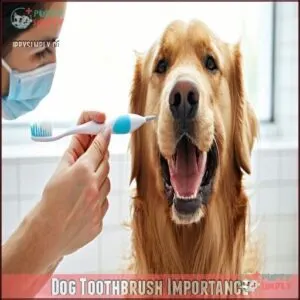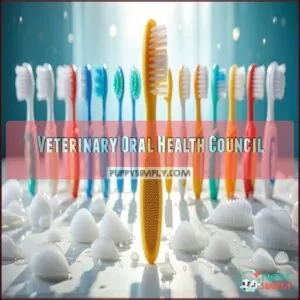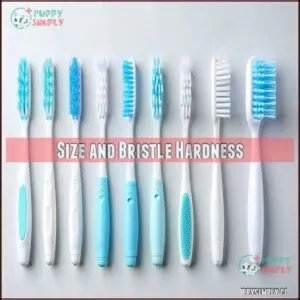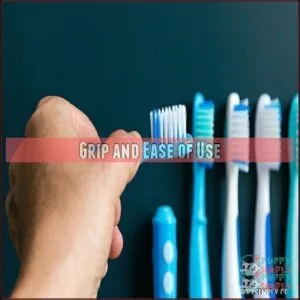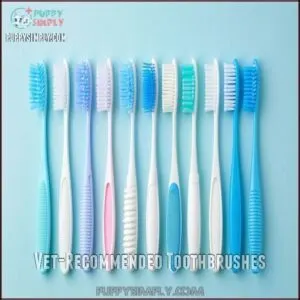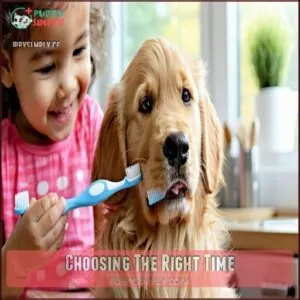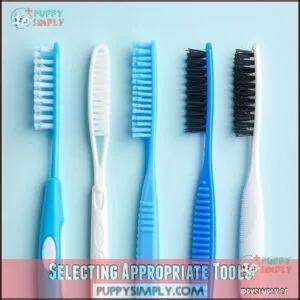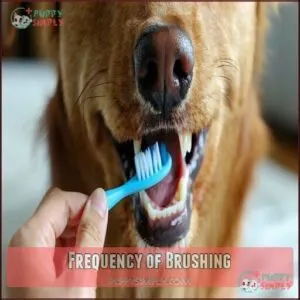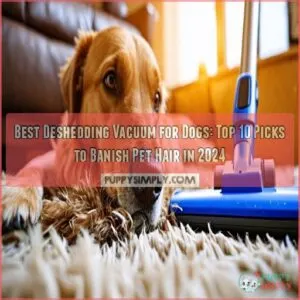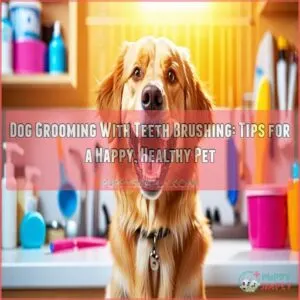This site is supported by our readers. We may earn a commission, at no cost to you, if you purchase through links.
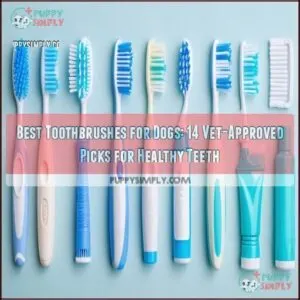 Choosing the best toothbrushes for dogs is essential for keeping their teeth clean and their gums healthy.
Choosing the best toothbrushes for dogs is essential for keeping their teeth clean and their gums healthy.
Look for options approved by the Veterinary Oral Health Council (VOHC), as these meet high standards.
Double-headed brushes are great for reaching both sides of the teeth, while finger brushes work well for smaller dogs or nervous pups.
Soft bristles are a must to avoid damaging sensitive gums.
Some top picks include dual-ended brushes for versatility, electric options for thorough cleaning, and kits with enzymatic toothpaste for added plaque control.
Regular brushing prevents tartar and keeps your dog’s smile bright and healthy.
Table Of Contents
- Key Takeaways
- Dog Toothbrush Importance
- Choosing Dog Toothbrush
- Brushing Techniques Tips
- 14 Best Toothbrushes for Dogs
- 1. Pet Toothbrush Kit Plaque Tartar Control
- 2. Natural Dog Toothbrush And Paste Kit
- 3. Dual Ended Pet Toothbrush VOHC Approved
- 4. Dog Toothbrush Set 3 Pack Dual Headed
- 5. Enzymatic Toothpaste Kit for Pets
- 6. Vet Best Dog Toothbrush 10 Pack
- 7. Soft Small Dog Cat Toothbrush
- 8. Arm and Hammer Dog Tartar Control Kit
- 9. Nylabone Puppy Dental Kit Original 3 Count
- 10. Tough Dog Dental Chew Toys
- 11. Dog Electric Toothbrush for Dental Care
- 12. Pet Oral Hygiene Toothbrush Kit
- 13. Pet Toothbrush for Small Animals
- 14. Pet Toothbrush Kit For Dogs
- Maintaining Good Dog Oral Health
- Frequently Asked Questions (FAQs)
- What is the best dog toothbrush for dogs?
- Are there different types of dog toothbrushes?
- What is the best alternating rubber and bristle toothbrush for dogs?
- What is the best dental finger brush for dogs?
- Are angled toothbrushes good for dogs?
- What toothbrush should a senior dog use?
- What type of dog toothbrush is best?
- What do vets recommend for brushing dogs teeth?
- What human toothbrush is safe for dogs?
- What toothpaste do vets recommend for dogs?
- Conclusion
Key Takeaways
- Pick a toothbrush with soft bristles and the right size to fit your dog’s mouth comfortably, ensuring effective cleaning without irritating gums.
- Choose VOHC-approved toothbrushes for proven safety and effectiveness in reducing plaque and tartar.
- Use finger brushes for better control with small dogs or as a gentle introduction for nervous pups.
- Pair the toothbrush with enzymatic toothpaste to maximize plaque removal and protect your dog’s oral health.
Dog Toothbrush Importance
Brushing your dog’s teeth is essential for preventing plaque buildup, gum disease, and other oral health issues.
Brushing your dog’s teeth daily keeps plaque at bay and protects their health, one wagging tail at a time.
Regular dental care doesn’t just protect their teeth—it can also safeguard their overall health.
Preventing Plaque and Tartar Buildup
Plaque removal in dogs starts with regular brushing and smart tools.
A dog toothbrush paired with daily care keeps tartar under control.
Boost your dog’s dental care with these simple steps:
- Offer chew toys for natural cleaning and tartar control.
- Use water additives to support plaque removal.
- Incorporate dental diets to improve dog teeth cleaning.
These steps are designed to work together to provide comprehensive dental care for your dog, focusing on plaque removal and overall oral health.
Avoiding Serious Health Issues
Neglecting dog dental care can lead to more than bad breath.
Poor dental care in dogs can cause bad breath and lead to serious health risks like gum disease and organ damage.
Gum disease isn’t just about sore gums—it’s a gateway to serious health risks.
Bacteria from untreated periodontal disease can travel through the bloodstream, causing heart, kidney, and liver problems.
Think of brushing as your dog’s shield against these systemic threats.
Regular plaque removal and tartar control protect their overall well-being.
To facilitate a thorough approach, consider prescription dental food to help reduce tartar buildup.
| Problem | Cause | Impact on Health | Prevention |
|---|---|---|---|
| Periodontal Disease | Plaque Buildup | Organ Health Impact | Daily Brushing |
| Gingivitis | Tartar Accumulation | Gum Disease Risks | Gum Disease Prevention |
| Bacterial Infections | Poor Oral Hygiene | Systemic Disease Link | Professional Cleanings |
| Organ Damage | Untreated Infections | Overall Well-being Decline | Consistent Dog Dental Care |
Professional Cleanings Are Important
Even with regular brushing, some tartar sneaks under the radar. That’s why professional cleanings are a must.
Your veterinarian uses specialized tools for deep cleaning, including dental scaling and gumline cleaning. Here’s what to expect:
- Dental examination: A thorough check for hidden issues.
- Anesthesia risks: Managed carefully by a veterinary technician.
- Tartar removal: Reaches spots brushing can’t.
- Cost factors: Worth it for long-term health.
Aim for annual cleanings to keep your pup’s smile healthy!
Choosing Dog Toothbrush
Picking the right toothbrush for your dog is all about balancing comfort, effectiveness, and ease of use.
You’ll want to evaluate factors like bristle softness, handle design, and size so that your pup’s teeth get the care they need without causing discomfort.
Veterinary Oral Health Council
When choosing a vet-recommended toothbrush, look for the VOHC Seal of Approval. It’s like a gold star from veterinary experts, ensuring the product meets strict VOHC standards for plaque and tartar control through clinical trials.
VOHC-approved products are trusted by veterinarians for their safety and effectiveness.
Here’s why VOHC certification matters:
- Proven effectiveness: Products reduce plaque and tartar buildup.
- Safety assurance: Tested to avoid causing harm to your dog.
- Veterinarian recommendations: Backed by veterinary experts.
- Reliable quality: Meets rigorous VOHC standards.
- Confidence in use: Trusted by dog parents and professionals alike.
Stick with VOHC-accepted products for healthier, happier teeth!
Size and Bristle Hardness
Dog toothbrush sizes matter—small dog toothbrushes suit compact mouths, while large dog toothbrushes handle bigger teeth.
Bristle softness is essential for gum sensitivity, especially in puppy brushes or dogs needing tartar control. A soft-bristled brush guarantees cleaning without irritation.
Veterinarians recommend annual dental checkups for early detection of dental issues.
| Dog Size | Brush Type | Key Feature |
|---|---|---|
| Small breeds | Finger toothbrush | Easy to maneuver |
| Medium breeds | Dual-ended toothbrush | Versatile cleaning |
| Large breeds | 3-sided toothbrush | Covers more surface |
Choose wisely for healthier smiles and consider the importance of annual dental checkups to ensure your dog’s oral health is well-maintained, which is crucial for their overall well-being, and remember that proper dental care is key.
Grip and Ease of Use
Finding an easy dog toothbrush starts with handle comfort. Look for an ergonomic design with non-slip materials to keep control, even if your pup squirms.
Brushes with a flexible neck or angled head improve bristle reach, especially for back teeth. Finger toothbrushes are great for small dogs, offering finger grips for precision.
Prioritize bristle softness to protect gums, regardless of your dog’s size.
Vet-Recommended Toothbrushes
When picking a vet-recommended toothbrush, look for VOHC Approval to guarantee safety and effectiveness.
Prioritize bristle softness to protect your dog’s gums, especially if they’re sensitive. Handle ergonomics matter too—an easy grip makes brushing less of a hassle.
Material safety is vital; opt for non-toxic, pet-safe designs. Cost analysis helps balance quality with affordability.
Always consult your veterinarian for guidance on the best dog toothbrush for your pup’s needs. Look for toothbrushes with the VOHC seal of acceptance for verified quality.
A good toothbrush is key to maintaining excellent dog dental health!
Brushing Techniques Tips
Brushing your dog’s teeth isn’t just about grabbing a brush and going at it—it takes the right tools and a gentle approach.
With a little patience and consistency, you can make dental care a stress-free part of your routine.
Choosing The Right Time
A quiet moment, like after meals or before bedtime, makes brushing easier.
Post-meal brushing suits adult dog teeth, while puppies need softer tools for teething comfort.
Gradual introduction is key—let them sniff the toothbrush first.
Build a daily routine with positive reinforcement, like treats or praise, and remember that puppy dental care thrives on patience, turning brushing into a fun, stress-free habit.
Selecting Appropriate Tools
The best dog toothbrush combines Bristle Softness, Handle Ergonomics, and Head Size to guarantee comfort and effective cleaning.
Finger brushes work well for small dogs, while larger breeds benefit from long-handled or dual-headed designs.
Material Safety is key—choose BPA-free options for stress-free brushing. Brush Type matters too; soft dog toothbrush bristles protect sensitive gums.
Consider a specialized puppy toothbrush for younger dogs. Always pick tools suited to your dog’s needs for a hassle-free routine and healthier teeth.
Be Gentle and Reward Good Behavior
Start with a gentle introduction to dog teeth brushing, using a finger brush or the best dog toothbrush for comfort.
Keep sessions short and calm, showing patience—it’s essential for a stress-free brushing experience.
Use positive reinforcement like treats or praise right after. Regular grooming helps with early health detection.
Timing rewards well creates a positive experience, helping your dog associate brushing with something enjoyable. Gradual progression builds trust.
Frequency of Brushing
A consistent brushing schedule is essential for dog dental hygiene.
Daily brushing is ideal to prevent plaque buildup and maintain gum health, but starting with weekly brushing works too.
Gradually increase frequency for better results.
- Brush every 1-2 days to stop tartar formation.
- Use a dog toothbrush for effective cleaning.
- Stick to a regular dog teeth brushing routine.
14 Best Toothbrushes for Dogs
Choosing the right toothbrush for your dog is essential for maintaining their oral health and preventing serious issues like gum disease.
We’ve rounded up 14 vet-approved options to make brushing easier and more effective for you and your pup.
1. Pet Toothbrush Kit Plaque Tartar Control
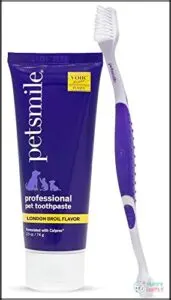
Looking for an all-in-one solution for your dog’s dental care? The Arm & Hammer Tartar Control Kit has you covered.
This practical and affordable kit includes a dual-ended toothbrush, a finger brush, and enzymatic toothpaste infused with baking soda for natural, effective cleaning.
It’s designed to tackle plaque and tartar buildup while being gentle on your dog’s gums. Perfect for puppies and adult dogs alike, the kit also helps freshen breath and improve gum health.
Just brush two to three times a week, and you’ll notice the difference. Plus, the finger brush makes it easy to introduce brushing to hesitant pups, promoting natural cleaning and effective care.
Best For: Pet owners looking for an affordable, comprehensive dental care solution for dogs of all sizes and ages.
- Includes dual-ended toothbrush, finger brush, and enzymatic toothpaste for complete oral care.
- Baking soda and enzymes effectively clean teeth and freshen breath.
- Gentle on gums, safe for puppies, and enjoyable flavors for pets.
- Some pets may resist toothbrushing despite flavor.
- Regular use required for noticeable results.
- Limited flavor options available.
2. Natural Dog Toothbrush And Paste Kit
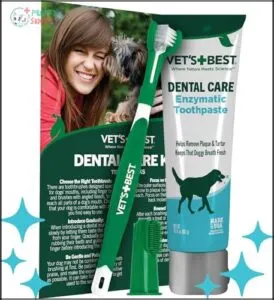
The Natural Dog Toothbrush and Paste Kit is a game-changer for keeping your pup’s teeth in tip-top shape.
Its triple-sided toothbrush design cleans all sides of the teeth in one go, making brushing faster and easier.
The toothpaste, packed with natural ingredients like aloe and neem oil, soothes gums while tackling plaque and tartar.
Plus, the natural flavors guarantee your dog actually enjoys the process—no more wrestling matches at brushing time.
Regular use promotes fresher breath, healthier gums, and a happier, healthier dog.
This all-in-one kit simplifies dental care, making it a must-have for any pet parent’s routine.
Best For: Pet owners looking for an easy and natural solution to maintain their dog’s oral health.
- Triple-sided toothbrush for faster, thorough cleaning.
- Natural enzymatic toothpaste for plaque and tartar removal.
- Dog-friendly flavors make brushing enjoyable.
- Toothbrush and toothpaste usually sold only as a kit.
- May require acclimation for dogs not used to brushing.
- Some dogs may be sensitive to certain natural ingredients like neem oil.
3. Dual Ended Pet Toothbrush VOHC Approved
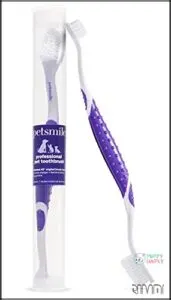
The dual-ended pet toothbrush is a must-have for keeping your dog’s teeth in top shape.
With its VOHC-approved design, the 45° angled bristles tackle plaque below the gumline while polishing enamel, giving your pup a thorough clean.
The smaller brush head is perfect for reaching tricky spots, like back molars, while the ergonomic handle guarantees you won’t struggle with grip during brushing.
It’s versatile enough for dogs of all sizes, making it a reliable choice for multi-pet households.
Pair it with a pet-safe toothpaste for the best results.
Regular use can prevent gum disease and keep your furry friend’s smile healthy and bright—no vet visits for avoidable dental issues!
Best For: Pet owners seeking an effective, VOHC-approved toothbrush that suits both small and large dogs or cats for improved oral health.
- Dual-ended design accommodates pets of all sizes.
- 45° angled bristles effectively clean below the gumline.
- Ergonomic, non-slip handle ensures a comfortable grip.
- Requires consistent use for noticeable results.
- Brush head replacement frequency is not mentioned.
- Effectiveness with non-Petsmile toothpaste is unclear.
4. Dog Toothbrush Set 3 Pack Dual Headed
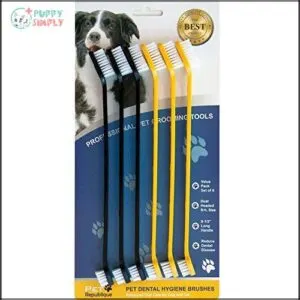
In terms of reliable dental care for dogs, the Dog Toothbrush Set 3 Pack Dual Headed is a smart pick.
Its dual-head design, featuring both small and large brush heads, suits dogs of all sizes, from tiny pups to larger breeds.
The long, ergonomic handle makes it easier for you to reach those difficult back teeth during a brushing session. Soft, pet-friendly bristles guarantee gentle cleaning without irritating gums, though they may wear out with regular use.
Lightweight and durable, this set is budget-friendly and convenient, with a bonus: 15% of profits help animal rescue organizations. It’s an effective way to care for your dog while giving back.
Best For: Pet owners looking for a cost-effective, easy-to-use toothbrush set for maintaining their dog’s dental health.
- Dual-headed design for cleaning upper and lower teeth simultaneously.
- Ergonomic handle ensures comfortable grip and control.
- Soft bristles are gentle on gums and enamel.
- Bristles may wear out with frequent use.
- Requires gradual introduction for pets unaccustomed to brushing.
- Only compatible with dog-specific toothpaste, not human varieties.
5. Enzymatic Toothpaste Kit for Pets
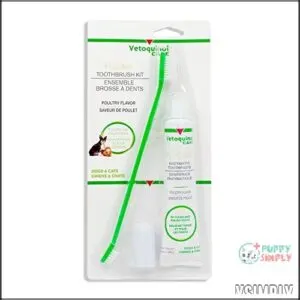
The Enzymatic Toothpaste Kit for pets is a game-changer for keeping your dog’s teeth and gums healthy.
Its triple-enzyme formula actively fights bacteria, reduces plaque, and improves overall dental health.
With a poultry-flavored toothpaste, brushing becomes a treat for your dog instead of a chore.
The included toothbrush is effective for large dogs, but if your pup has sensitive gums or a smaller mouth, a softer or smaller toothbrush may be more comfortable.
Since the toothpaste is safe to swallow and doesn’t need rinsing, the process is simpler for both of you.
Pair with regular brushing and routine vet visits for the best results!
Best For: Pet owners looking for an easy, effective way to maintain their dog’s dental health with minimal fuss.
- Triple-enzyme formula effectively reduces plaque and bacteria.
- Poultry-flavored toothpaste makes brushing enjoyable for pets.
- Safe to swallow, eliminating the need for rinsing.
- Included toothbrush may not suit pets with small mouths or sensitive gums.
- Only one flavor offered, which may not appeal to all pets.
- Requires daily use for maximum effectiveness.
6. Vet Best Dog Toothbrush 10 Pack
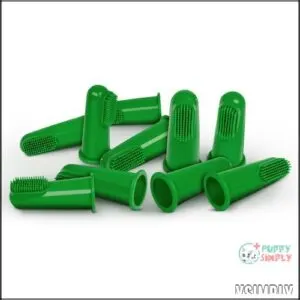
Looking for a hassle-free way to keep your dog’s teeth sparkling? Vet’s Best Dog Toothbrush 10 Pack has you covered.
These silicone finger brushes fit snugly, giving you full control and making brushing easy. The soft bristles protect your pup’s gums while effectively removing plaque and tartar.
Made from safe, BPA-free materials, they’re reusable and simple to clean. Each brush adapts seamlessly to small and medium fingers to prevent slipping, though they might feel tight on larger hands.
Perfect for both seasoned pet parents and beginners, these brushes guarantee your dog’s dental health stays on point. A practical pick for clean teeth and fresh breath every day!
Best For: Pet owners looking for an easy, safe, and effective way to maintain the dental health of their cats or dogs.
- Soft bristles protect gums while removing plaque and tartar effectively.
- Made from BPA-free, food-grade materials for safety.
- Snug fit ensures control and easy cleaning of hard-to-reach areas.
- Fits small to medium fingers only, which might be tight for larger hands.
- Brushes need regular cleaning for reuse.
- Limited appeal to owners preferring traditional toothbrush designs.
7. Soft Small Dog Cat Toothbrush
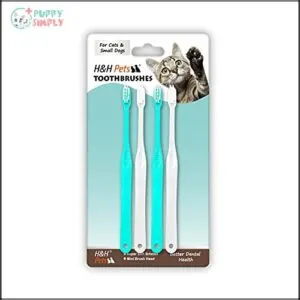
If you’ve got a small dog or cat, the Soft Small Dog Cat Toothbrush could be your new go-to tool for dental care.
With its compact size and ultra-soft bristles, it’s gentle on sensitive gums and ideal for smaller mouths.
The ergonomic handle provides a comfortable grip, ensuring easy, controlled brushing.
Designed with delicate pets in mind, it helps reduce plaque and tartar while making your brushing routine less stressful.
As a bonus, many owners attach a yarn loop to the handle for quick identification.
If your furry friend dislikes brushing, this toothbrush might make things a little easier!
Best For: Small dogs and cats with sensitive gums and smaller mouths.
- Ultra-soft bristles for gentle cleaning.
- Compact size designed for easy use.
- Helps reduce plaque and tartar with regular use.
- Requires gradual pet acclimation to brushing.
- Needs replacement every three months.
- Not suitable for larger pets.
8. Arm and Hammer Dog Tartar Control Kit
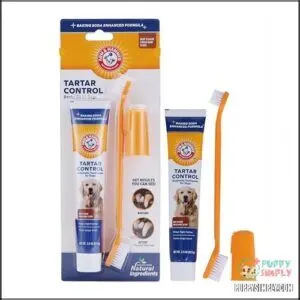
If you’re looking for a simple yet effective way to care for your dog’s teeth, the Arm & Hammer Dog Tartar Control Kit might be your go-to.
This kit fights tartar, whitens teeth, and tackles bad breath with its beef-flavored toothpaste—although not all pups may love the scent.
Featuring a dual-headed toothbrush for big dogs and a gentle finger brush for targeted cleaning, it’s versatile and easy to use.
Safe for both adult dogs and puppies, you should aim to brush two to three times a week, and start slowly to ease your dog’s comfort.
You’ll soon notice healthier gums and happier smiles!
Best For: Pet owners looking for an affordable, natural, and easy-to-use dental care solution for their dogs or puppies.
- Reduces tartar, whitens teeth, and freshens breath.
- Includes a dual-headed brush and finger brush for versatility.
- Safe and effective for all dog sizes and ages.
- Beef scent may be strong and linger on hands.
- Some dogs may dislike the flavor or smell.
- Toothbrush durability may not suit all breeds.
9. Nylabone Puppy Dental Kit Original 3 Count
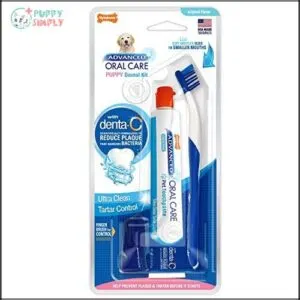
The Nylabone Puppy Dental Kit is a simple and effective way to care for your pup’s teeth.
It comes with a soft-bristled toothbrush, a flexible finger brush, and a flavorful toothpaste formulated just for puppies.
The soft bristles are gentle on sensitive gums, while the angled brush head helps you reach tricky spots with ease.
Start your puppy off with the finger brush—it’s perfect for getting them comfortable with brushing.
Once they’re used to the routine, switch to the handle brush for more thorough cleaning.
Building good dental habits early can prevent costly vet visits down the road.
Consider supplementing their diet with food that reduces tartar buildup for ideal dental care.
Pair this dental kit with chew toys or dental treats to round out their oral hygiene routine.
Best For: Puppies and small adult dogs (up to 20 lbs) who need a gentle dental care solution to maintain oral hygiene.
- Sodium Lauryl Sulfate may irritate sensitive gums.
- Peanut butter flavor may not appeal to all pets.
- Toothbrush durability limited to about a month with daily use.
- Soft bristles and angled toothbrush head for gentle and effective cleaning.
- Includes finger brush for better control while brushing squirmy dogs.
- Formulated toothpaste with Denta-C to reduce plaque and tartar buildup.
10. Tough Dog Dental Chew Toys
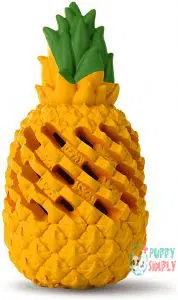
If your dog’s a tough chewer, the M.C.works Pineapple Dog Chew fits the bill.
Made from durable, non-toxic rubber, it’s tough enough for breeds like German Shepherds or Pitbulls while also promoting dental health.
Its unique hollow design lets you stuff it with treats, turning cleaning time into playtime.
At 7.5" tall and 3.6" wide, it’s perfectly sized for medium to large dogs.
This chew toy helps reduce plaque and tartar buildup, keeping teeth cleaner between brushing sessions.
Many pet parents rave about its long-lasting durability, even for power chewers.
It’s a fun, practical way to keep your pup entertained and healthy!
Best For: Dogs that are aggressive chewers, such as German Shepherds or Pitbulls, and need a durable, treat-stuffable toy for dental health.
- Made from durable, non-toxic rubber for safety and strength.
- Unique hollow design allows for treat-stuffing to enhance playtime.
- Helps reduce plaque and tartar buildup, improving dental health.
- Limited to medium to large dogs due to its size.
- May not appeal to dogs uninterested in treat-stuffable toys.
- Heavier than some toys, which may not suit smaller or less active dogs.
11. Dog Electric Toothbrush for Dental Care
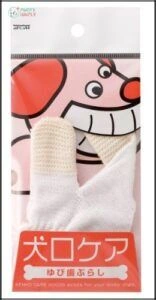
An electric toothbrush can be a game-changer for your dog’s oral care.
These brushes offer advanced cleaning by using ultrasonic or sonic technology to reach hidden plaque and tartar in those tight spots.
With features like multiple cleaning modes and adjustable intensity levels, you can easily tailor the brushing experience to your dog’s needs—whether they’re a laid-back pup or a bit nervous about new gadgets.
Start slow: let your dog sniff the toothbrush while it’s off, then gradually introduce the vibration.
Always use a pet-safe toothpaste, as human versions aren’t safe for dogs.
Over time, using an electric toothbrush can improve oral health, prevent dental issues, and reduce the need for professional cleanings, making it a valuable tool for a laid-back pup or any dog, and it is a good way to prevent issues and have good dental care.
Best For: Pet owners seeking an effective, advanced solution for maintaining their dog’s oral health with minimal effort.
- Offers thorough cleaning, reaching tight spots with ultrasonic or sonic technology.
- Adjustable modes make it suitable for both calm and nervous dogs.
- Prevents dental issues and reduces the need for professional cleanings.
- May require time to get dogs accustomed to the device.
- Only compatible with pet-safe toothpaste, which may be an additional purchase.
- Some dogs may resist using an electric toothbrush despite gradual introduction.
12. Pet Oral Hygiene Toothbrush Kit
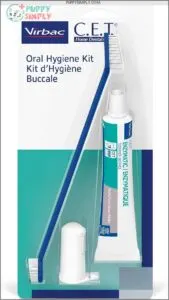
Designed for convenience and effectiveness, the Pet Oral Hygiene Toothbrush Kit features a patented four-head design to clean your dog’s teeth thoroughly and fast.
The ergonomic handle guarantees a comfortable grip, making it easier to maneuver into those hard-to-reach spots.
Plus, the kit’s stand-up storage feature helps keep everything clean between uses.
Available in two sizes, it’s perfect for small dogs under 25 lbs or larger breeds.
The included enzymatic toothpaste blends natural ingredients like Aloe, Manuka Honey, and Baking Soda for a gentle yet powerful clean.
This all-in-one kit simplifies your pet’s dental care routine while delivering complete, vet-approved oral hygiene every time.
Best For: Pet owners looking for an all-in-one, vet-approved dental care solution for dogs of any size.
- Features a patented four-head toothbrush for thorough and fast cleaning.
- Includes enzymatic toothpaste with natural ingredients like Aloe and Manuka Honey.
- Ergonomic handle ensures comfortable grip and easy maneuvering.
- Available only in two size options, which may not fit all pets perfectly.
- Stand-up storage may require extra counter space.
- Focused primarily on dogs, with limited mention of suitability for cats.
13. Pet Toothbrush for Small Animals
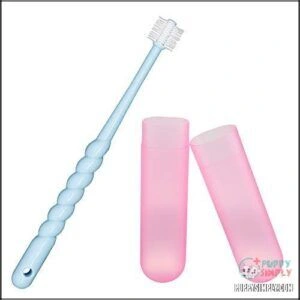
In the case of caring for small pets like Yorkies, Chihuahuas, and kittens, a well-designed toothbrush makes all the difference.
The Pet Toothbrush for Small Animals features a smart 360-degree rotation design, ensuring every tooth gets the attention it needs.
Its super soft bristles are gentle yet effective, enhancing gum health while removing stubborn plaque buildup.
At 6 inches, the ergonomic handle gives you better grip and control than finger brushes, making brushing easier and more efficient.
With 10 times more bristles than traditional options, this toothbrush cleans those hard-to-reach areas effortlessly, providing excellent investment for your furry friend, and its ability to thoroughly clean and maintain oral health makes it a valuable tool, despite some pet owners noting its premium price.
Best For: Small pets like Yorkies, Chihuahuas, kittens, and other small animals with sensitive teeth and gums.
- 360-degree design ensures thorough cleaning with optimal coverage.
- Super soft bristles remove plaque while being gentle on gums.
- Ergonomic handle provides comfortable grip and control.
- Premium price may not suit all budgets.
- Designed specifically for small pets, not ideal for larger animals.
- Requires regular cleaning to maintain effectiveness.
14. Pet Toothbrush Kit For Dogs
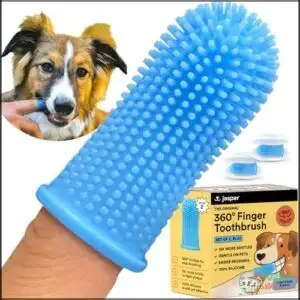
For a reliable and easy-to-use dental care solution, the Pet Toothbrush Kit for Dogs is a smart pick.
This kit features a 360° silicone finger brush that makes it simple to clean every corner of your dog’s mouth, even the hard-to-reach spots. The soft, BPA-free silicone adapts to different finger sizes using a water-activated expansion feature, ensuring a snug fit that doesn’t slip mid-brushing.
Pair it with enzymatic toothpaste for the best results. The included storage case keeps things organized, and the durable design means this kit will last.
Many pet owners notice fresher breath and cleaner teeth with regular use. Keep in mind, though, that those with larger hands may find the fit a bit tight.
Each kit provides a six-month supply.
Best For: Pet owners looking for a convenient, silicone-based finger brush to improve their dog’s dental hygiene, especially for medium to large breeds.
- 360° silicone finger brush for comprehensive cleaning.
- Water-activated expansion for a secure and adjustable fit.
- BPA-free, durable, and easy-to-clean design.
- May not fit comfortably for users with larger hands.
- Less effective for pets under 12 lbs.
- Needs to be replaced every three months for hygiene.
Maintaining Good Dog Oral Health
Keeping your dog’s teeth clean isn’t just about fresh breath—it’s key to preventing serious health issues like gum disease and organ damage.
Regular brushing, safe dental tools, and professional cleanings can make a world of difference for your pup’s overall health.
Toothbrush Materials and Safety
Making the right choice for a dog toothbrush boils down to safety and smart materials. Look for BPA-free and phthalate-free options to avoid harmful material toxicity.
Soft bristles reduce gum irritation, keeping brushing sessions petsafe and comfortable. Silicone and biodegradable materials are great choices, especially for eco-conscious pet owners.
Avoid toothbrushes with small, detachable parts that could pose choking hazards. Durable, non-toxic handles provide better grip, letting you brush with confidence.
Prioritize a well-made toothbrush for dogs to protect their teeth and gums while ensuring their overall health. Many owners are now prioritizing dog toothbrush safety.
Regular Dental Check-Ups Are Essential
Taking great care of your dog’s teeth at home is smart, but it’s just one piece of the puzzle.
Regular dental check-ups with your veterinarian are the key to catching issues before they snowball into painful (and pricey) problems. Your vet will perform a professional oral health assessment and may recommend treatments suited to your pup’s needs.
Schedule checkups every 6-12 months as part of your dog’s routine care.
Here’s why it matters:
- Early Detection: Spot trouble like gum disease or loose teeth early.
- Preventative Care: Avoid costly, advanced procedures.
- Comprehensive Monitoring: Anesthesia-concerns? Vets guarantee your dog’s safety during professional dental care.
Benefits of Professional Cleanings
How can you stay on top of your dog’s dental health?
Professional dental care is key. These cleanings go beyond brushing, targeting plaque removal and tartar prevention deep below the gumline, boosting gum health.
Done under anesthesia, they guarantee your dog’s comfort and safety during the process. Plus, they allow veterinarians to spot hidden issues early, saving costly treatments later.
Regular cleanings safeguard oral health while keeping your dog’s smile and overall well-being in tip-top shape, which is crucial for their dental health.
Frequently Asked Questions (FAQs)
What is the best dog toothbrush for dogs?
Imagine a toothbrush that’s a perfect fit—like a key to a lock.
The Virbac C.E.T. Dual-Ended Dog Toothbrush stands out with soft bristles, dual heads for versatility, and a vet-recommended design.
Are there different types of dog toothbrushes?
Dog toothbrushes come in various types: double-ended brushes for versatility, finger brushes for control, electric brushes for efficiency, and eco-friendly options.
Each suits different needs, ensuring clean teeth while keeping your pup comfortable.
They provide a range of benefits, including versatility, to cater to different requirements.
What is the best alternating rubber and bristle toothbrush for dogs?
For a mix of rubber and bristle cleaning, the Arm & Hammer Spectrum 360 Degree Toothbrush is a top pick.
Its dual materials help clean teeth effectively, offering thorough access to hard-to-reach spots, with the dual materials being a key feature.
What is the best dental finger brush for dogs?
In the context of dental finger brushes, Vet’s Best Dental Finger Dog Toothbrush takes the crown.
Its silicone, non-slip design fits snugly, ensuring comfort and effective cleaning for both your hands and your pup’s teeth.
Are angled toothbrushes good for dogs?
Angled toothbrushes are great for dogs because they help you reach back molars more easily, improving cleaning efficiency.
Their design guarantees better access to hard-to-reach spots, reducing plaque buildup and promoting healthier gums and teeth.
What toothbrush should a senior dog use?
Think of your senior dog’s mouth as a well-loved book—gentle handling is key.
Use a soft-bristled toothbrush, like a finger brush or dual-ended brush, to clean sensitive gums while ensuring comfort and thorough care.
What type of dog toothbrush is best?
For the best cleaning and comfort, choose a toothbrush with soft bristles and an angled handle.
Dual-ended brushes work great for versatility, while finger brushes are ideal for puppies or dogs wary of traditional brushes.
What do vets recommend for brushing dogs teeth?
Brushing a dog’s teeth is like guarding their smile against unseen invaders.
Vets advise using soft-bristled toothbrushes designed for dogs, paired with pet-safe toothpaste, to prevent plaque, gingivitis, and serious health issues.
Start gently!
What human toothbrush is safe for dogs?
A soft-bristled, pediatric toothbrush can work safely for your dog.
Its smaller head and gentle bristles help protect gums while effectively cleaning teeth.
Just make certain to avoid toothpaste made for humans—it’s harmful to pets!
What toothpaste do vets recommend for dogs?
You might worry about harmful chemicals, but vets recommend enzymatic dog toothpaste like Virbac C.E.T.
It’s safe, fights plaque, and tastes like poultry.
Skip human toothpaste—it contains xylitol, which can harm your pup.
Conclusion
An ounce of prevention is worth a pound of cure, and the best toothbrushes for dogs play a key role in maintaining their oral health.
Regular brushing reduces tartar, prevents gum disease, and keeps your dog happy.
Choose VOHC-approved brushes with soft bristles and the right size for your pup’s mouth.
Pair them with enzymatic toothpaste for added protection.
Consistency is everything, so brush often and visit your vet for check-ups.
Your dog’s smile will thank you!

